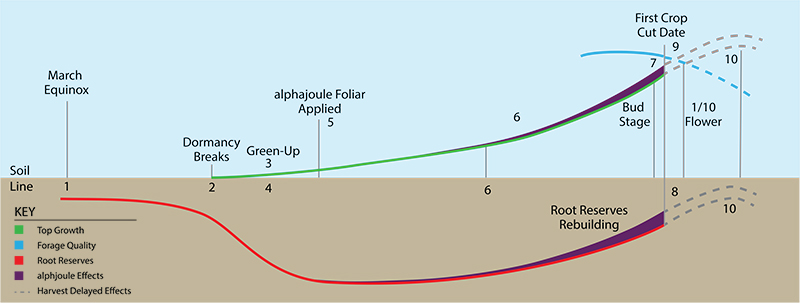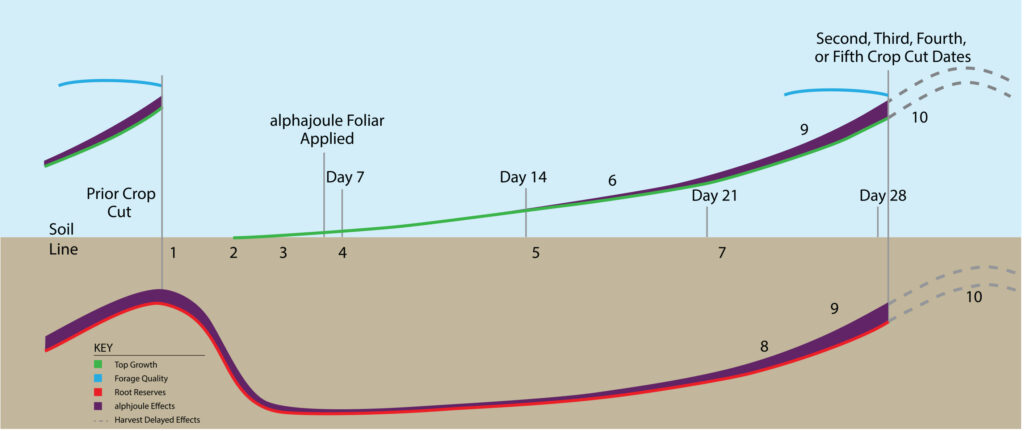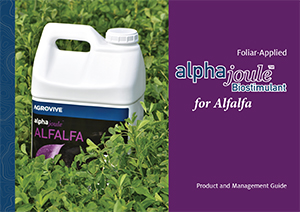Alfalfa and Bacteria Working Together
The Emergence of Biostimulants in Agriculture
Biostimulants aren’t new to agriculture. Seed and silage inoculants, for example, have been around for decades and have lead the way for other beneficial products onto the farm. Today’s high-performing biostimulants have gained enough grower acceptance to be recognized as a new ag input category in the 2018 U.S. Farm Bill.
This acceptance of a wide range of biostimulants has been driven by consumer preference and conventional crop producers. These producers are looking for more efficient and environmentally friendly crop production systems. Current sustainability trends are certain to further accelerate grower acceptance of biostimulants for agriculture. alphajoule for alfalfa is leading the way in the forage sector.
alphajoule™ Biostimulant for Alfalfa Technical Description
alphajoule from Agrovive, Inc. is an in-plant biostimulant for alfalfa. It is comprised of proprietary strains of Pseudomonas flouresense and Bacillus megatarium bacteria. These natural, non-GMO, patent pending bacteria strains were screened for their ability to recycle nutrients, impact water use efficiency, and reduce the effects of abiotic and biotic stressors on alfalfa growth at the cellular level.
 The endophytic bacteria, alphajoule, live in the inner cellular spaces and the cell walls of the roots, crown, stems and leaves of the alfalfa plant. These parts of the plant are where metabolism and cell division are regulated. The bacteria and the host cells have a symbiotic relationship that promote plant health, photosynthesis, carbohydrate production, and performance efficiencies.
The endophytic bacteria, alphajoule, live in the inner cellular spaces and the cell walls of the roots, crown, stems and leaves of the alfalfa plant. These parts of the plant are where metabolism and cell division are regulated. The bacteria and the host cells have a symbiotic relationship that promote plant health, photosynthesis, carbohydrate production, and performance efficiencies.
When stress begins to adversely affect cell functions in any part of the alfalfa plant, the production of ethylene is triggered. Ethylene is an anti-growth hormone that slows vital cell functions in the plant such as photosynthesis. The hormone promotes early maturity and leaf drop if not alleviated. The multi strains of bacteria in alphajoule mediate ethylene production in the stressed plant at a sub-clinical level. In turn, this reduces the potential effects on yield, maturity, quality, or persistence.
Living, growing, plant cells produce waste. Alfalfa with alphajoule bacteria living within it efficiently utilizes waste as a food source. Through metabolism, the plant and alphajoule recycle tied-up micronutrients and essential growth compounds to the plant cells to renew and maintain plant functions.
Below-Ground Carry-Forward Benefits
alphajoule in Action
The above ground effects of alphajoule are seen and measured through the season as each crop is harvested. Below ground effects of alphajoule remain hidden and out of sight unless plants are dug and evaluated. As an explanation of the below ground benefits of alphajoule, the diagrams below show the cycle of an alfalfa plant.
In the field, carbohydrate energy for root and root hair growth, as well as root reserve replenishment, come from the top growth of the alfalfa plant during the two week period before harvest. At this time, alphajoule biostimulant bacteria are recycling cell waste and mitigating abiotic and biotic stress within the plant to maximize carbohydrate production.
Winter, Spring Green-Up, and First Crop
Details of the relationship between root reserves, top growth, and harvest timing.

- Cell metabolism during dormancy draws down root reserves.
- Driven by temperature, crown bud release is initiated using root reserves.
- Temperature and light intensity drive green-up and photosynthesis with 80% of carbohydrates being used for spring top growth.
- Root reserves are used to repair winter injury to roots, root hairs and to generate new top growth due to late frosts.
- alphajoule Biostimulant applied to 3-5” of top growth.
- At 10-14” of top growth, surplus carbohydrates rapidly begin translocating to the root, while supporting auxiliary branching.
- First crop is cut at late bud stage with a yield boost attributed to alphajoule.
- alphajoule impacts rebuilding root reserves which carry forward to the next crop; however, carbohydrate transfer to the root ceases at cutting.
- In-plant alphajoule bacteria leave the field with the forage.
- Dotted lines indicate growth, quality, and root reserve curves if harvest had been delayed to mid-flower.
Summer and Early Fall Crops
Details of the relationship between root reserves, top growth, and harvest timing.

- Day 1 of a 28-day aggressive cut system.
- Crown buds emerge using root reserve energy.
- Photosynthesis begins to support top growth.
- Root reserves continue to be drawn down to support crown health, root and root hair growth, repair harvest injury, repair pathogen damage, and provide energy for rhizobia.
- Surplus carbohydrates are available to translocate to the roots.
- Auxiliary branching initiates.
- Dry matter yield increases rapidly during the week prior to cutting. On-farm side-by-side trials have shown up to a 30% yield increase from the application of alphajoule, with an average increase of 12-13% over multiple cuts and locations.
- Root reserve translocation accelerates.
- alphajoule’s mediation of abiotic and biotic stress, waste recycling, and efficient water use are expressed as carried-forward benefits, additional dry matter yield, and root reserves.
- The dotted line illustrates potential yield and root reserve curves if harvest had been delayed to mid-flower.
Post Harvest and Early Winter
Details of the relationship between root reserves, top growth, and harvest timing.

- The carry-forward benefits of alphajoule in the management system.
- Crown buds emerge.
- Fall top growth is determined by variety dormancy ratings, the reaction to decreasing day light length and intensity, and declining temperature.
- During late summer and fall, plants translocate a higher percentage of carbohydrates produced to the root than they do during spring and early summer to support the dormancy reaction.
- Dry matter accumulation is slow and decreases as photosynthesis slows and leaves are lost to frost.
- The growing season has ended.
- Top growth deteriorates, with stubble left to catch snow.
- Plant cells begin to draw down root reserves to support metabolism.
- All alphajoule bacteria have left the field as forage or succumbed to frost and frozen soil.
Download the Product and Management Guide
Links
- ROI Calculator
- Product Label
- Safety Data Sheet


